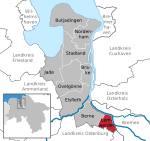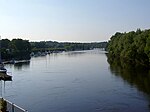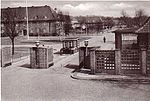Schwanewede

Schwanewede is a municipality in the district of Osterholz, in Lower Saxony, Germany. It is situated approximately 14 km west of Osterholz-Scharmbeck, and 22 km northwest of Bremen. It belonged to the Prince-Archbishopric of Bremen. In 1648, the Prince-Archbishopric was transformed into the Duchy of Bremen, which Sweden first ruled over in a personal union. In 1715, the Hanoverian Crown started to rule over Schwanwede until 1823, in which the Duchy was abolished, leading all of its territory to become part of the Stade Region. Schwanewede consists of 12 smaller villages which form the municipality of Schwanewede, namely Beckedorf, Löhnhorst, Meyenburg, Aschwarden, Neuenkirchen, Brundorf, Eggestedt, Harriersand, Hinnebeck, Leuchtenburg and Rade. The Farge concentration camp is located in Schwanewede-Neuenkirchen.
Excerpt from the Wikipedia article Schwanewede (License: CC BY-SA 3.0, Authors, Images).Schwanewede
Eggestedter Straße,
Geographical coordinates (GPS) Address Nearby Places Show on map
Geographical coordinates (GPS)
| Latitude | Longitude |
|---|---|
| N 53.233333333333 ° | E 8.6 ° |
Address
Eggestedter Straße
Eggestedter Straße
28790
Lower Saxony, Germany
Open on Google Maps









